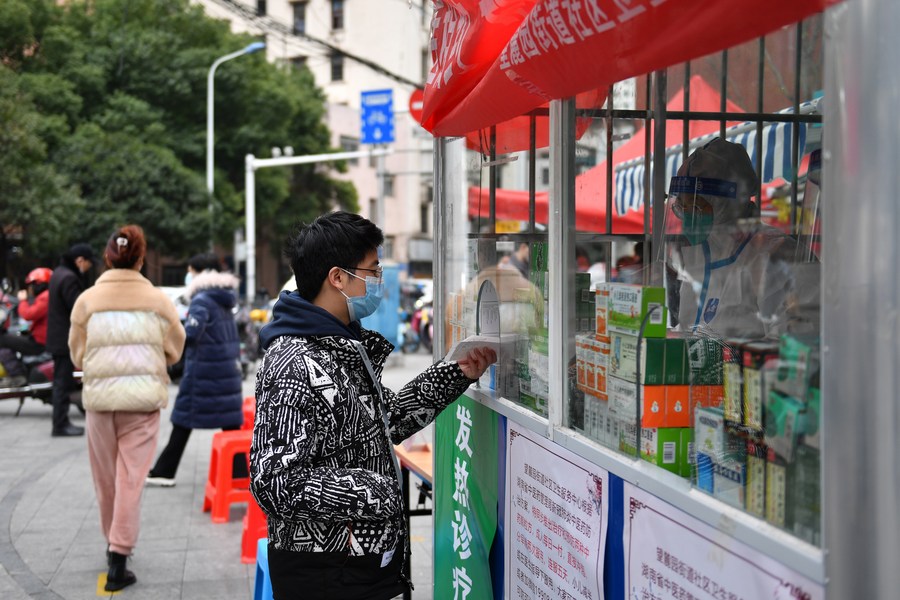Health experts shed light on key COVID-19 concerns through FAQs

A resident collects medicine at a fever clinic in Kaifu District of Changsha, central China's Hunan Province, Dec. 20, 2022. (Xinhua/Chen Zhenhai)
BEIJING, Dec. 22 (Xinhua) -- China is working all out to meet people's basic and urgent needs in the trying time of combating COVID-19.
Xinhua reporters interviewed seven experts from the State Council's joint prevention and control mechanism against COVID-19, in response to some questions of common public concern. The following are some key points of the FAQs.
Q1: What virus variants are currently prevalent in China?
Xu Wenbo, director of the National Institute for Viral Disease Control and Prevention, the Chinese Center for Disease Control and Prevention (China CDC): There are two sub-strains of Omicron variant BA.5 that are mainly prevalent in China now, namely BA.5.2 and BF.7, with the former dominating in Guangzhou while the latter is in Beijing.
Q2: Are there any differences in symptoms caused by the two virus strains?
Tong Zhaohui, vice president of the Beijing Chao-Yang Hospital: The virulence, pathogenicity and infectiousness of the virus will not have fundamental changes as long as it belongs to an Omicron strain, and the differences in symptoms are related to personal immunity, age group, and underlying health conditions.
Q3: Someone believes being infected means having antibodies, is that right?
Wang Huaqing, chief immunologist at the China CDC: Omicron infection is still posing risk of severe cases and even deaths, which is particularly pronounced among the elderly and those with underlying medical conditions. Vaccination can reduce the risk, and the full course of inoculation and booster jabs are important.
Q4: What about the undersupply in medicines treating COVID-19 symptoms?
Zhou Jian, an official with the Ministry of Industry and Information Technology: The government is leaving no stone unturned to help pharmaceutical enterprises ensure stable production and expand capacity, particularly ramping up the supply of some key medicines.
For the accurate distribution of medicines, local authorities have worked to give priority to hospitals, nursing homes and other key sites, and mobilize qualified pharmacies to develop online shopping platforms.
Q5: How to solve the problem of waiting in long queues at fever clinics?
Jiao Yahui, an official with the National Health Commission (NHC): Efforts have been made to address the inaccessibility of medical services for patients with fever, including setting up more fever clinics or consulting rooms and streamlining outpatient procedures. In the meantime, health authorities are putting great energy into promoting classified diagnosis and treatment and internet-based medical services.
Q6: How to meet the basic medical demands of the elderly, pregnant women, and patients with chronic diseases?
NHC official Gao Guangming: Primary-level medical institutions have been required to make a list of vulnerable groups, including the elderly living alone, pregnant women, patients with underlying health conditions, and hemodialysis patients, to see to it that they have access to medical services when necessary.
Q7: Is the latest variation of the virus detectable?
Xu Wenbo: The National Institute for Viral Disease Control and Prevention, China CDC, has made a work plan to monitor the virus variant in China.
According to the plan, all the provincial-level regions will select three hospitals each in three different cities, which are required to collect samples from 15 COVID-19 infections, 10 severe cases, and all the deaths reported in a week, followed by genome sequencing and analysis. The related data must be uploaded within a week.
By doing so, the prevalence of new Omicron variants in China, and the possible symptoms, transmissibility and pathogenicity of new variants with potential biological changes can be monitored and updated in real time, which will provide scientific references for vaccine development and assessment on diagnosis kits.
Photos
Related Stories
- Inhalable COVID-19 vaccines available at vaccine sites in Changsha
- Work at full steam to boost medicine supply for epidemic control
- Testing booths turned into fever clinics as China battles COVID-19
- Japan reports 206,943 new COVID-19 cases amid 8th wave of infections
- Fever clinics set up in Chinese cities to provide timely treatment to patients
- What should be the yardstick to assess countries' COVID responses?
Copyright © 2022 People's Daily Online. All Rights Reserved.









